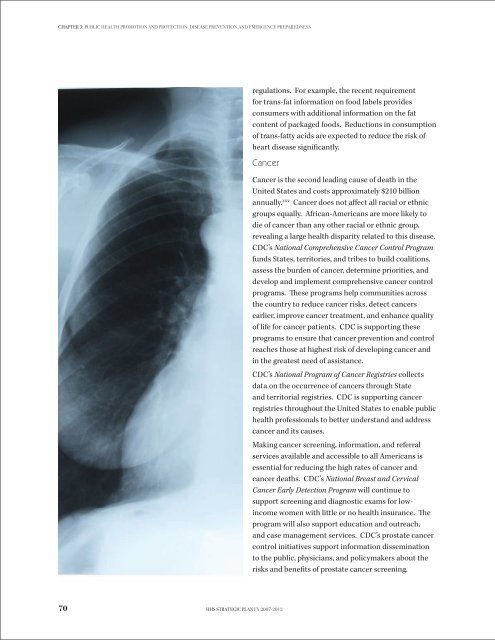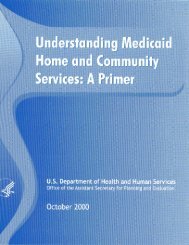STRATEGIC PLAN - ASPE - U.S. Department of Health and Human ...
STRATEGIC PLAN - ASPE - U.S. Department of Health and Human ...
STRATEGIC PLAN - ASPE - U.S. Department of Health and Human ...
Create successful ePaper yourself
Turn your PDF publications into a flip-book with our unique Google optimized e-Paper software.
CHAPTER 3: Public <strong>Health</strong> Promotion <strong>and</strong> Protection, Disease Prevention,<strong>and</strong> Emergency Preparednessregulations. For example, the recent requirementfor trans-fat information on food labels providesconsumers with additional information on the fatcontent <strong>of</strong> packaged foods. Reductions in consumption<strong>of</strong> trans-fatty acids are expected to reduce the risk <strong>of</strong>heart disease significantly.CancerCancer is the second leading cause <strong>of</strong> death in theUnited States <strong>and</strong> costs approximately $210 billionannually. xxv Cancer does not affect all racial or ethnicgroups equally. African-Americans are more likely todie <strong>of</strong> cancer than any other racial or ethnic group,revealing a large health disparity related to this disease.CDC’s National Comprehensive Cancer Control Programfunds States, territories, <strong>and</strong> tribes to build coalitions,assess the burden <strong>of</strong> cancer, determine priorities, <strong>and</strong>develop <strong>and</strong> implement comprehensive cancer controlprograms. These programs help communities acrossthe country to reduce cancer risks, detect cancersearlier, improve cancer treatment, <strong>and</strong> enhance quality<strong>of</strong> life for cancer patients. CDC is supporting theseprograms to ensure that cancer prevention <strong>and</strong> controlreaches those at highest risk <strong>of</strong> developing cancer <strong>and</strong>in the greatest need <strong>of</strong> assistance.CDC’s National Program <strong>of</strong> Cancer Registries collectsdata on the occurrence <strong>of</strong> cancers through State<strong>and</strong> territorial registries. CDC is supporting cancerregistries throughout the United States to enable publichealth pr<strong>of</strong>essionals to better underst<strong>and</strong> <strong>and</strong> addresscancer <strong>and</strong> its causes.Making cancer screening, information, <strong>and</strong> referralservices available <strong>and</strong> accessible to all Americans isessential for reducing the high rates <strong>of</strong> cancer <strong>and</strong>cancer deaths. CDC’s National Breast <strong>and</strong> CervicalCancer Early Detection Program will continue tosupport screening <strong>and</strong> diagnostic exams for lowincomewomen with little or no health insurance. Theprogram will also support education <strong>and</strong> outreach,<strong>and</strong> case management services. CDC’s prostate cancercontrol initiatives support information disseminationto the public, physicians, <strong>and</strong> policymakers about therisks <strong>and</strong> benefits <strong>of</strong> prostate cancer screening.70 HHS Strategic Plan FY 2007-2012
















